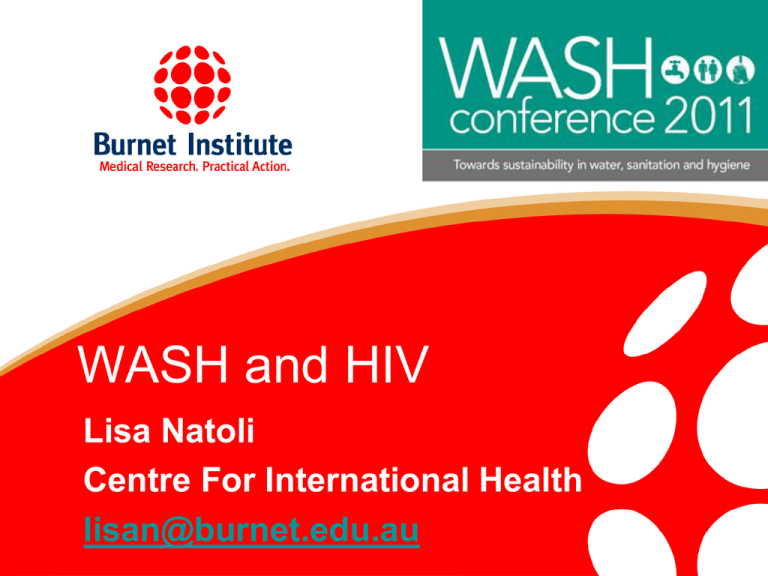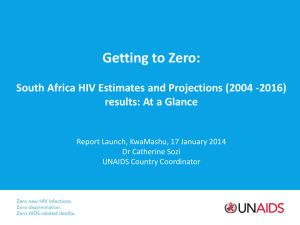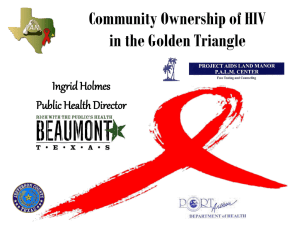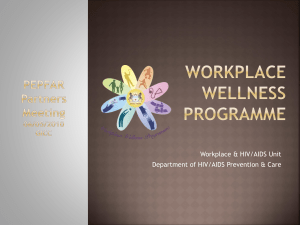
WASH and HIV
Lisa Natoli
Centre For International Health
lisan@burnet.edu.au
Overview
• Why integrate WASH into HIV/AIDS
programmes? (and vice versa)
• Explore additional WASH needs of people
living with HIV and AIDS
• Identify priority WASH practices to integrate
into HIV/AIDS programmes
• Identify key considerations when integrating
HIV into WASH programmes
• Share experiences
• Highlight some useful resources
Where do you stand on WASH and HIV?
• ...Haven’t given it much
thought.
• ...Have been ‘watching
that space’.
• ...Planning to engage,
not sure where to start.
• ...Currently
programming.
Why integrate WASH into HIV/AIDS
programmes? (USAID/WHO 2010)
• Effects of access to WASH are magnified
for HIV+/immune-compromised
• susceptibility to opportunistic infections
such as diarrhoea (Lule et al. 2005)
• Infections reduce quality of life and can speed
progression from HIV to AIDS (?)
• Diarrhoea reduces absorption of ARVs and
essential nutrients (Bushen et a. 2004)
• evidence on WASH needs/health impacts
of WASH interventions, for HIV+ people and
their families
Why integrate WASH into HIV/AIDS
programmes? (USAID/WHO 2010)
• WASH practices can
– episodes & severity of
diarrhoea among HIV+ people
– help to protect caregivers/other
household members from
diarrhoeal disease (& HIV)
• A healthier/stronger
household is more
economically viable
and resilient to the
challenges of HIV
Doris lives in the western highlands of Papua
New Guinea. She spends much of her time
caring for her dependant husband, Fidelis.
Fidelis is chronically ill with AIDS related
illnesses, and suffers from regular bouts of
debilitating diarrhoea.
Doris found out she was HIV positive after
being tested during an antenatal care visit
early in 2010. Baby William is now six months
old and is HIV negative.
*
*
What are the likely WASH needs
of Doris and her family?
ACCESS to
ADEQUATE
AMOUNTS of GOOD
QUALITY WATER for:
drinking; taking ARVs;
food preparation;
? replacement feeding;
washing clothes;
personal hygiene
ACCESS to
SANITATION for
safe handling and
disposal of faeces
and items soaked
with menstrual
blood
WASH needs
of Doris and
her family
HYGIENE:
hand washing;
menstrual
management;
food hygiene.
Basic water needs of people living with
HIV & AIDS
(USAID/WHO 2010)
1 l/day. Water for replacement feeding
of infants <6 mths (w/o cleaning)
1.5 l/day. Water for taking ARVs.
2 l/day. Water for replacement feeding
of infants > 6 mths (w/o cleaning)
20-80* l/day. Hygiene needs of
person living with HIV, laundering
clothes and bedding.
20 l/day min. Basic water for drinking,
food preparation, laundering &
personal hygiene
In case you are wondering....?
FLUID
Urine &
faeces
KEY POINT
HIV has never been isolated in urine or faeces.
(Water Environment Federation, 2000)
Urine and faeces quickly (in 1 hr) diminish infectivity
of any HIV present.
(Moore BE, 1993; Water Environment Federation, 2000)
Likely to be more virus in faeces of people with end
stage AIDS. Risk to caregivers more likely to be due
to other pathogens in faeces.
Menstrual Menstrual blood of HIV+ women may contain virus
blood
at a higher load than regular blood
(Reichelderfer PS et al, 2000)
Waste
HIV infected blood introduced into dechlorinated tap
water
water had no detectable virus after 5 mins.
(Moore BE, 1993)
And what about the
WASH needs of other
marginalised groups
whose behaviours put
them at increased risk of
HIV or other
communicable diseases?
• Although WASH needs of
HIV+ people exceed the
needs of those who are
uninfected, they often have
less access to water and
sanitation facilities than their
neighbours (Magrath and
Tesfu 2006).
• Stigma and discrimination is exacerbated for people who
sell sex or inject drugs
• Hand washing before injecting is protective against many
infections, including blood borne viruses
• Access to safe water for people who inject drugs is critical,
as it reduces a range of complications
Priority WASH practices to integrate into
HIV/AIDS programmes (USAID/WHO 2010)
Treat drinking water
Store treated drinking water safely
Promote hand washing
Handle and dispose of faeces safely
Manage menstruation
Prepare, handle and store food safely
Promote personal cleanliness of people living with HIV and
their environment
Why integrate HIV into WASH sector
programmes? (USAID/WHO 2010)
• Government Ministries often work in silos
• Access to WASH is a basic human right
(for everyone!); needs of HIV+ people
often exceed those of general popn.
• Houses who have lost primary income
earners are less able to pay for
water/latrines
• Fewer able bodied people in households
means fewer people able to manage and
engage with water/sanitation activities
(Franks & Cleaver 2002)
• Most WASH related programmes do not
address HIV/AIDS (Kamminga &
Wegelin-Schuringa 2005)
WATER
HEALTH
Key considerations for integrating HIV into
water supply and sanitation activities
• Protecting sectoral human resources through HIV
prevention and mitigation activities
• Considering special hardware needs of those affected
by HIV in WASH programmes and activities, for
example
– lengthening pump handles to make it easier to
pump water
– building wells or latrines closer to HIV affected
households
– building ramps or platforms for easier access
• ‘GIPA’ principles
Experience of AT in PNG......
• http://www.wateraid.org/uk/what_we_do/how_we_work/equ
ity_and_inclusion/8321.asp
– Studies, examples from Nepal, Tanzania, Ethiopia, India
• http://www.watercentre.or
g/projects/sharingexperiences-hygiene
– Hygiene Improvement
Project, Ethiopia,
Uganda, Kenya,
Tanzania
http://www.wsscc.org/topics/hot-topics/hiv/aids-and-wash
http://www.hip.watsan.net/page/4489
• WASH-HIV Integration Toolkit
– A collection of resources from
the Hygiene Improvement
Project and others to support
the integration of water,
sanitation, and hygiene (WASH)
in HIV/AIDS programming.
• Also see publications and
resources link
http://www.hip.watsan.net/page/4142
Need help?
• Burnet Centre for International Health can assist with:
– preparing design documents
– Developing M & E Frameworks
– Performing operational research
– Etc
Contact:
Lisa Natoli, lisan@burnet.edu.au
(03) 9282 2136







